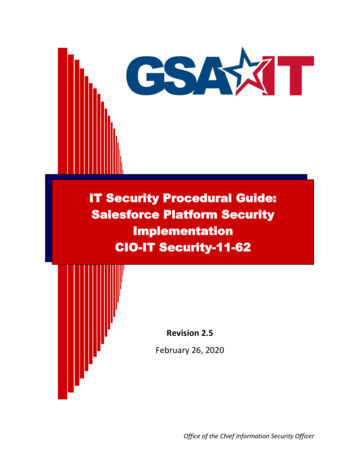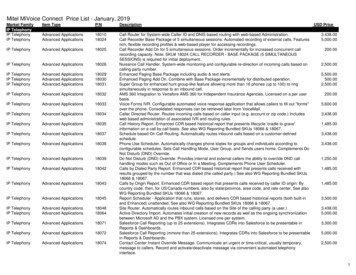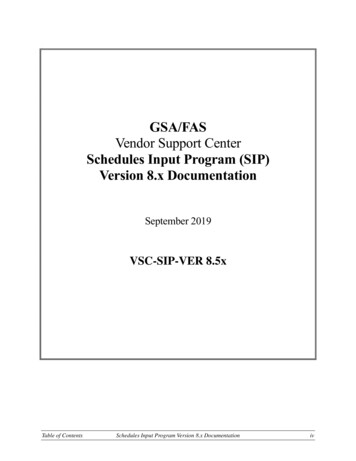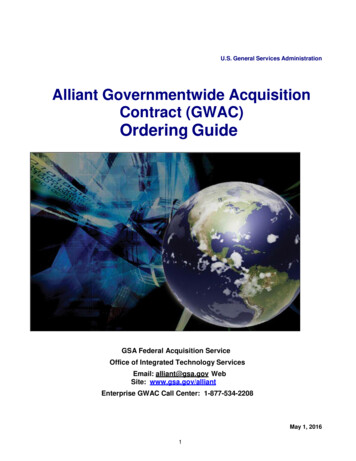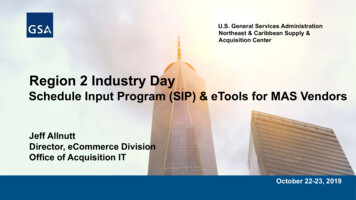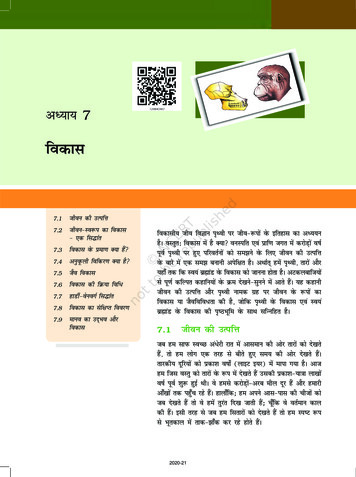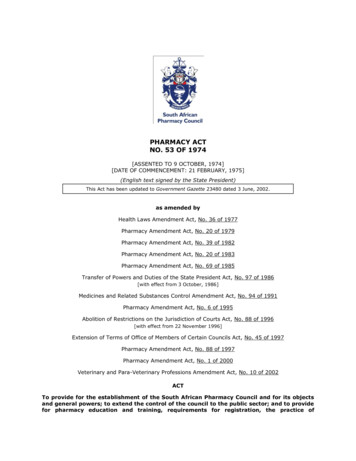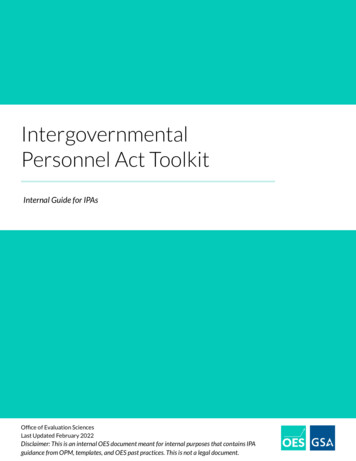
Transcription
IntergovernmentalPersonnel Act ToolkitInternal Guide for IPAsOffice of Evaluation SciencesLast Updated February 2022Disclaimer: This is an internal OES document meant for internal purposes that contains IPAguidance from OPM, templates, and OES past practices. This is not a legal document.
IntroductionThe Office of Evaluation Sciences (OES) uses the Intergovernmental Personnel Act (IPA) MobilityProgram to bring on unique talent to support agency priorities and evidence needs.The U.S. Office of Personnel Management defines IPA agreements as:“The temporary assignment of personnel between the Federal Government and state and localgovernments, colleges and universities, Indian tribal governments, federally funded research anddevelopment centers, and other eligible organizations.”The purpose of this toolkit is to provide internal guidance on how OES has utilized the IPAMobility Program in the past to fill highly technical positions in a quick and simple way where theremight otherwise be capacity gaps. Personnel with IPAs at OES have served in roles as fellows,academic affiliates, and statistical methods support.OES has experience utilizing the IPA program with dozens of nonprofit and academic institutionsin order to bring on behavioral science experts to conduct low-cost, rapid-cycle evaluations acrossgovernment. This internal toolkit is not meant to be a comprehensive summary of the IPA program- but rather share information on how we have previously conducted IPA agreements withindividuals interested in serving in IPA roles.This Toolkit includes: General Overview List of Institutions with OES IPAs Past Roles at OES & Alumni Examples Frequently Asked Questions IPA Form GuidanceComplete and Current Guidance from OPM on the IPA Mobility Program can be found here.2
General OverviewObjectivesThe goal of the Intergovernmental Personnel Act mobility program is to facilitate the movement ofemployees, for short periods of time, when this movement serves a sound public purpose. Mobilityassignments may be used to achieve objectives such as: strengthening the management capabilities of federal agencies, state, local and Indiantribal governments, and other eligible organizations;assisting the transfer and use of new technologies and approaches to solving governmentalproblems;facilitating an effective means of involving state and local officials in developing andimplementing federal policies and programs; and,providing program and developmental experience which will enhance the assignee'sperformance in his or her regular job.Eligibility Employees of a non-federal organization in career positions that have been employed forat least 90 days prior.A non-federal organization can be a state and local governments, colleges and universities,Indian tribal governments, and non-profit institutionsAgencies are responsible for certifying the authenticity of a partner institution categorizedas an “other organization.” If an organization has already been certified by an agency, thiscertification is permanent and may apply throughout the Federal Government.Excluded from Assignment:Individuals excluded from participation in the Intergovernmental Personnel Act mobility programinclude: Federal, State or local government employees serving under time-limited, temporary orterm appointment, non-career or limited SES appointments, or Schedule C appointments;Elected Federal, State or local government officials;Members of the uniformed military services and the Commissioned Corps of the PublicHealth Service and the National Oceanic and Atmospheric Administration; andStudents employed in research, graduate, or teaching assistant and similar temporarypositions.Time Commitment Employee can be given a temporary position or detail assignmentAssignments may be intermittent, part-time, or full-time3
Note: OES has had IPAs ranging from 5% to 100% FTE time for time periodsranging from six months to up to four consecutive years.Assignment agreements can be made for up to two years. The agency head, or his or herdesignee, may extend an assignment for an additional two years when the extension will beto the benefit of both organizations.Employee Status Employees on an IPA assignment are on detail or leave without pay (LWOP). The assigneeremains an employee of his or her original organization and retains the rights and benefitsattached to that status. The position is subject to any personnel actions that may occur.CostsAgencies may enter into IPA assignments on a reimbursable or non-reimbursable basis.Cost-sharing arrangements for mobility assignments are negotiated between the participatingorganizations. The federal agency may agree to pay all, some, or none of the costs associated withan assignment according to the OPM guidance. Costs may include: Basic paySupplemental payFringe benefitsTravel expenses Note: OES has executed IPA agreements that were non-reimbursable, partiallyreimbursable, and fully reimbursable. For example, in the case where anacademic has an internal fellowship or is on sabbatical, reimbursement may notbe needed.According to OPM, other prohibited costs might include reimbursement or payment for employercontributions to employee benefit programs, tuition costs, family member benefits, office space,staff support, furnishings, and computer time. Outside consulting earnings may not bereimbursed, unless the assignee’s regular tour of duty in the non-Federal organization includedconsulting time that cannot be continued due to the IPA assignment.4
Previous Institutions with OES IPA AgreementsThe OES team has thus far worked with over 80 institutions on executing IPA agreements.This list is not exhaustive for all potential IPA institutions, but rather are examples ofinstitutions that OES has already worked with.Academic American UniversityAuburn UniversityBrown UniversityColumbia UniversityCornell UniversityDartmouth UniversityFlorida State UniversityGeorge Mason UniversityGeorgetown UniversityHarvard UniversityMassachusetts Institute of TechnologyMiami UniversityNorth Carolina State UniversityNortheastern UniversityPrinceton UniversityReed CollegeRutgers UniversitySwarthmore CollegeUniversity of California, San DiegoUniversity of ChicagoUniversity of Delaware University of FloridaUniversity of Illinois atUrbana-ChampaignUniversity of Maryland, College ParkUniversity of MissouriUniversity of San FranciscoUniversity of WashingtonNon-profit Association for Psychological ScienceFederation of American ScientistsIdeas42International Food Policy ResearchInstituteInternational Rescue CommitteeMDRCNational Bureau for EconomicResearchState/Local Government Covered California5
Past Roles for OES IPAsThis section details how OES has brought on team members through IPAs to fill a variety of roles.Fellows & Associate FellowsOES Fellows and Associate Fellows are selected through a formal recruitment process and arefully dedicated to deliver core OES projects.Responsibilities: Understand agency objectives and priorities, identifying opportunities to translate findingsfrom the social and behavioral sciences into concrete recommendations Drive implementation on 3-5 projects, including collaborating with agency partners toensure: intervention ideas and the design meet agency goals; field experiments are implemented as planned; and, the implications of results are clearly understood Work directly with agency collaborators to design and rigorously test interventions,perform data analysis and interpret results Distill findings into reports, policy memos, and academic publications Represent the team by presenting at government and external conferences and meetingsMethods TeamMethods Team Members are selected on-demand for specific skill sets and are usually dedicatedto functional tasks.Responsibilities: Conduct full replications of statistical analyses of randomized controlled trials (RCTs) andquasi-experimental evaluations, including preparing and cleaning data, conductingstatistical analysis, recording analytical methods and results, and collaborating with teammembers to diagnose and resolve any discrepancies with initial analysis Advise team members on the design of randomized controlled trials (RCTs) and otherrigorous evaluations, including estimating statistical power and advising on sample sizesrequired for achieving adequate power Consult on and contributing to statistical analysis plans for analyzing randomizedcontrolled trials (RCTs) and other rigorous evaluations Contribute to occasional written guidance for the team on key methodological/statisticalissues that arise in the course of OES projects6
Design FellowDesign fellows serve as experts in human centered design methods to embed qualitativeapproaches into how we develop solutions.Responsibilities: Serve as an advisor to OES project teams in developing and implementing qualitativeresearch activities as part of the project intervention design phase Engage in agency discussions and conversations to better understand barriers andopportunities for process changes; identify opportunities to translate findings fromhuman-centered design research, in addition to insights from the social and behavioralsciences, into concrete recommendations for improving Federal programs Apply leading practices in visual and content design into intervention artifacts, supportingOES projects on actual intervention design Drive the incorporation of service blueprints and behavioral maps into applicable OESprojects; including improving existing and creating additional mapping guides, resourcesand processes Represent the team by presenting at government and external conferences and meetingsas neededAcademic AffiliatesAcademic Affiliates support a subset of OES projects and are composed of former OES Fellows,academics serving as Principal Investigators on projects, and other technical advisors. AcademicAffiliates collaborate on one or more projects, usually on a part-time IPA.Responsibilities: Support delivery of rigorous evaluations with actionable findings for agency partners incollaboration with full-time OES team member Contribute to understanding bottlenecks and agency challenges, and designing evidencebased interventions in response to specific agency needs Assist in designing rigorous evaluation design to test intervention within agencyconstraints Perform data analysis and interpretation Distill findings into project reports and policy memos for academic, agency, and publicaudiences7
Selected OES IPA AlumniThis section details a few professional backgrounds of different IPA fellows at OES to shareexamples of individuals the team has brought on through IPA’s.Rekha Balu - Fellow and Academic AffiliateRekha Balu is a senior fellow at MDRC and directs its Center for Applied Behavioral Science.Rehka started with the team in 2019 as a full-time (100%) OES Fellow and has since thentransitioned to an academic affiliate (20% time). While at OES, Rekha worked on behavioralmapping and a range of projects with Social Security Administration, Housing and UrbanDevelopment, and Veterans Affairs. Her expertise is in Economics of Education and Public Policy.Jake Bowers - Fellow, Methods TeamJake teaches at the University of Illinois at Urbana-Champaign as an associate professor ofpolitical science and statistics. As an OES Fellow, Jake worked on the Methods Team to helpenhance the transparency and integrity of the research design and data analysis process of theteam. He worked virtually at OES from 2015 to 2019 in a part-time capacity (30% time).Crystal Hall - Fellow and Academic AffiliateCrystal is an Associate Professor of Public Policy and Governance at the University of Washington.In her time with OES, she focused on projects within the areas of Economic Opportunity andHealth. Crystal was on full-time (100%) assignment in DC in 2015 and part-time remote (30%time) agreements the following three years as an Academic Affiliate.Nuole (Lula) Chen - Methods SpecialistLula worked on the Methods Team at OES from 2016 to 2019 as a virtual Methods Specialist withtime commitments ranging from 25-80%. At OES, she worked on reanalysis, evaluation design,and reproducibility. Lula also provided feedback on OES projects and reviewed code. She iscurrently a PhD candidate in Political Science at the University of Illinois at Urbana-Champaign.Allyson Root - Associate Fellow and Academic AffiliateAllyson was a full-time (100%) Associate Fellow at OES from 2016 to 2017. She continued herwork with the team in a part-time capacity (10% time) from 2017 to 2018. While at OES, Allysonprimary worked on projects related to health and the use of patient entered health data. Allysoncompleted a PhD in Agriculture and Resource Economics at the University of California, Berkeleyin 2019.8
FAQs: Recruitment and Hiring Policy "Myth Busters."1The Office of Personnel Management (OPM) encourages agencies to re-think the following mythsand mis-perceptions:1. Myth: IPAs are popular and widely-used due to their flexibility.Truth: Agencies do not take full advantage of the IPA program which, if used strategically,can help agencies meet their needs for "hard-to-fill" positions such as InformationTechnology and Nurses.2. Myth: IPAs are cumbersome to use and require OPM approval.Truth: Agencies do not need OPM approval to make assignments under the IPA authority.Federal agencies interested in using the authority simply enter into a written agreement.3. Myth: IPAs are expensive to use.Truth: Agencies may enter into IPA assignments on a reimbursable or non-reimbursablebasis. This means they may be cost-neutral to Federal agencies. Whether an IPAassignment is reimbursable is determined by the agency and non-Federal entity involved inthe assignment.4. Myth: An agency may only enter into an IPA agreement with a State Government entity.Truth: An agency may enter into an IPA agreement with State and local governments,institutions of higher education, and Indian tribal governments.5. Myth: Agencies receive no recruitment benefit from sending employees on IPAassignments.Truth: Federal employees serving in IPA assignments can serve as both recruiters andambassadors for positions in your agency. For example, Federal nurses sent to colleges anduniversities as teachers/instructors can inspire students about Federal employment andencourage them to consider employment with your agency via the Pathways Program. Thisresults in a win-win for the academic institution as well as your agency.6. Myth: An agency may document IPA assignments for full-time employment only.Truth: An agency may document IPA assignments for intermittent, part-time, and full-timeemployment.1Hiring Information on the Intergovernmental Personnel Act from OPM, Last accessed October 8, 2019.9
IPA Form Guide & Sample AttachmentsBelow is an example of the IPA form used by OES and the U.S. General Services Administration.Full details on required information for IPA Mobility Program forms can be found at the OPMwebsite.10
11
12
13
14
15
16
time) agreements the following three years as an Academic Affiliate. Nuole (Lula) Chen- Methods Specialist Lula worked on the Methods Team at OES from 2016 to 2019 as a virtual Methods Specialist with time commitments ranging from 25-80%. At OES, she worked on reanalysis, evaluation design, and reproducibility.

